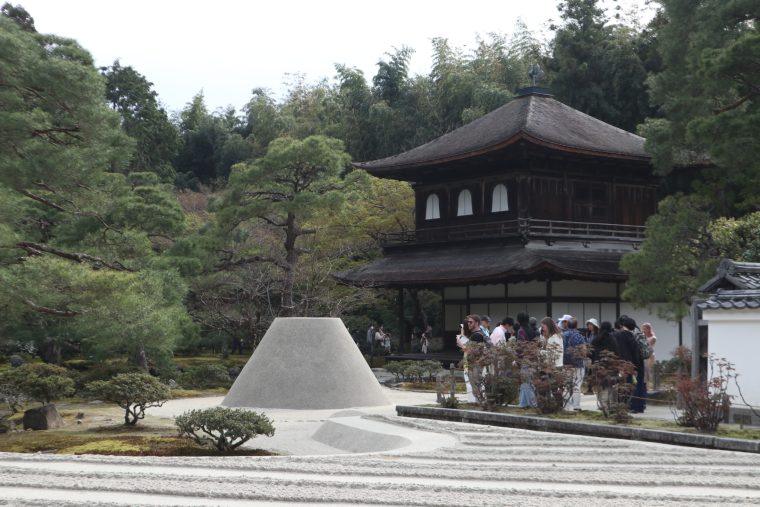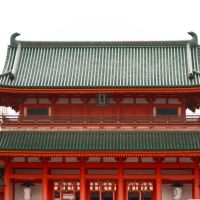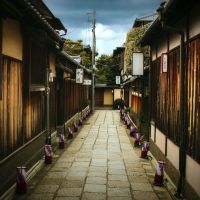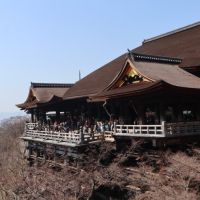Ginkakuji Temple (Ginkaku-ji): One of Kyoto’s World Heritage Sites embodying a culture of quality and serenity, Wabi-Sabi.
S-fleage
S-fleage is a Kyoto-based company. We are proud to introduce the charms of Kyoto to the world. We hope this article will help you to experience Kyoto.
Latest posts by S-fleage (see all)
When it comes to Kyoto, the “Golden Pavilion” Kinkakuji Temple and the “Silver Pavilion” Ginkakuji Temple are what most Japanese people immediately think of.
While the Kinkakuji Temple is a staple of Kyoto tourism, the Ginkakuji Temple also captivates many visitors, leaving them longing to return for more.
Let me introduce you to the highlights of the serene and rustic Ginkakuji Temple, where you can truly feel the essence of wabi-sabi.
Contents
A Brief History of Ginkakuji Temple
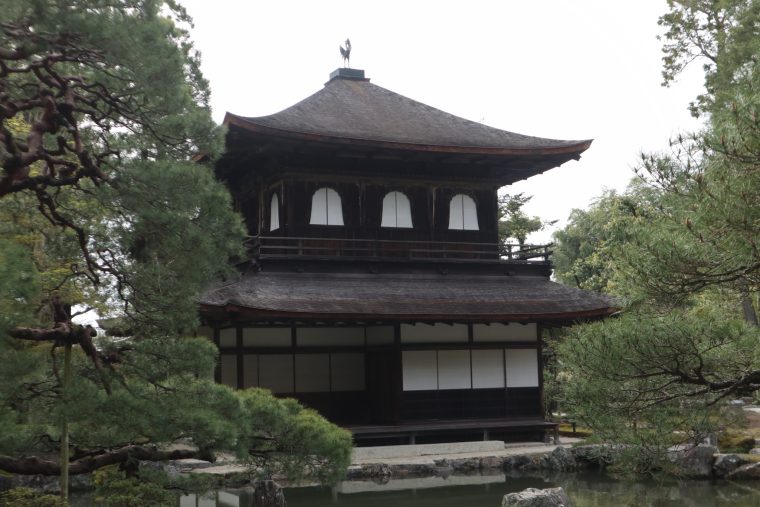
The only surviving garden architecture representative of the Muromachi period.
Ginkakuji Temple, formally known as Jisho-ji, was originally built in 1482 as the villa of the 8th shogun of the Muromachi Shogunate, Ashikaga Yoshimasa. After Yoshimasa’s passing, the villa was converted into a temple, and it later became known as “Ginkakuji Temple.”
Contrary to what the name might suggest, the temple buildings are not covered in silver. The name “Ginkakuji” was given in contrast to Kinkakuji (the Golden Pavilion), reflecting different periods and values. Kinkakuji symbolizes the opulence of the early Muromachi period, while Ginkakuji reflects the more austere beauty pursued by Yoshimasa in the later period.
The name “Ginkakuji” also reflects Yoshimasa’s intentions in its construction. Through Ginkakuji, he aimed to blend his aesthetic sensibilities with Zen teachings, charting new directions in Japanese art and culture.
Therefore, the name “Ginkakuji” embodies the cultural and historical significance of the temple, representing shifts in Japan’s aesthetic sensibilities and the influence of Yoshimasa and his era’s values.
How to Get to Ginkakuji Temple
Access to the famous tourist spot, Ginkakuji Temple, in Kyoto can be a bit tricky. Since there isn’t a nearby train station, getting there usually involves relying on buses from Kyoto Station. Head towards the Karasuma exit from Kyoto Station and transfer to a Kyoto City bus there.
Kyoto City buses have numerous routes, so it’s important to remember the numbers to reach your destination. For instance, you can take buses like Route 5 or Route 17 directly to Ginkakuji Temple without any transfers. The journey takes approximately 35 to 40 minutes, and the fare is 230 yen. Get off at Ginkakuji-michi and it’s about an 8-minute walk from there to Ginkakuji Temple.
Hours and Entrance Fees
The visiting hours for Ginkakuji Temple vary depending on the season.
During the summer season, from March 1st to November 30th, the temple is open from 8:30 AM to 5:00 PM. In the winter season, from December 1st to the end of February, the temple is open from 9:00 AM to 4:30 PM.
The admission fee for adults is 500 yen.
Highlights of Ginkakuji Temple
It’s typically about 30 minutes to visit Ginkakuji, but to fully appreciate its highlights, allocating around 50 minutes would be recommended. Ginkakuji’s attractions include the Kannonden Ginkaku, the Togudo, the Tea Garden, and the observation deck. Exploring these spots will allow you to gain a deeper understanding of Ginkakuji’s history and culture.
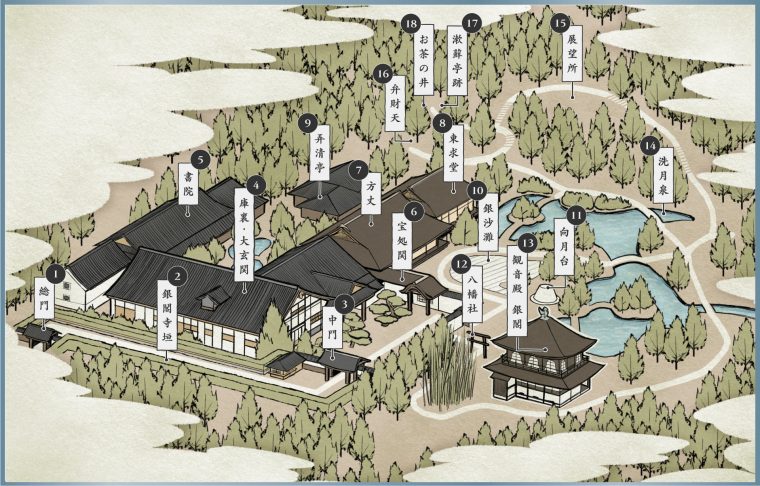
Map of Ginkakuji Temple
Source:GUIDE | Ginkaku-ji | 臨済宗相国寺派
https://www.shokoku-ji.jp/en/ginkakuji/guide/
Watch a video of Ginkakuji Temple
This is a video of Ginkakuji Temple. It’s perfect for getting a sense of what it’s like.
Kannonden Ginkaku (Map13)
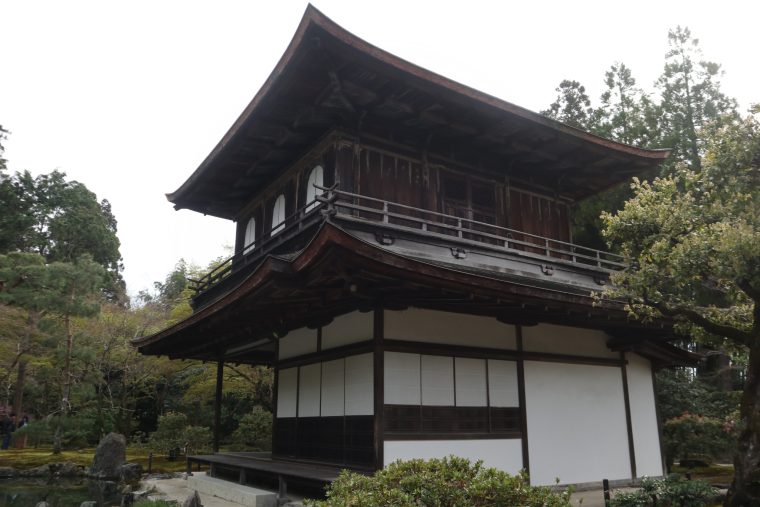
Kannonden, a national treasure and symbol of Ginkakuji Temple.
The Kannonden is a structure entrusted by Ashikaga Yoshimasa to embody his religious beliefs and aesthetics, reflecting his philosophies. Its architectural style consists of two stories: the first floor known as “Shinkuuden”, and the second floor known as “Shouonkaku.”
On the south side of Shinkuuden, there are no walls or sliding doors, offering a view of the Togudo across the Ginsyadan. This unique architectural style symbolizes the culture of the Muromachi period.
Furthermore, inside the Kannonden, there are wooden statues of Kannon Bodhisattva and a thousand Jizo statues enshrined.These Buddhist statues demonstrate Ashikaga Yoshimasa’s profound devotion.
Togudo(Map 8)
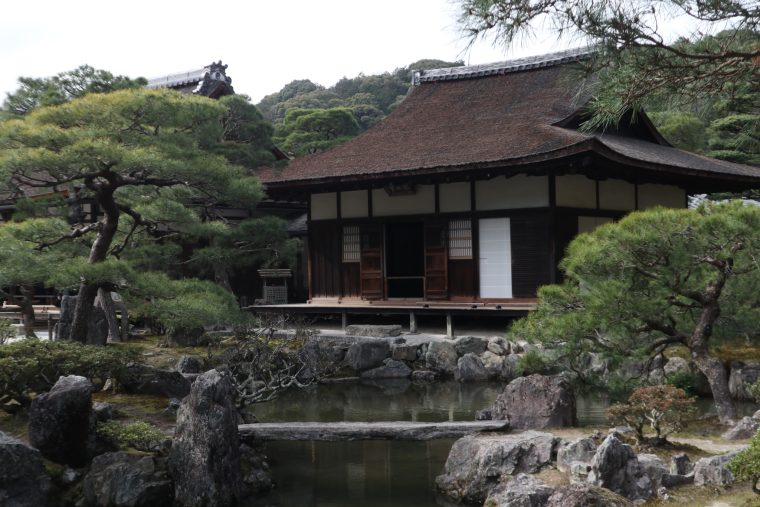
The Origin of Wabi Sabi.
Togudo is a representative architectural structure of the Muromachi period. It is one of the remnants of the Higashiyama Palace era, built by Ashikaga Yoshimasa in 1486 as a Buddhist hall, and is considered the oldest existing shoin-zukuri style building.
Together with Kannon-den Ginkaku, this building was part of Yoshimasa’s lifelong architectural endeavor, and its beautiful appearance has been preserved for over 500 years.
Of particular note is the four-and-a-half tatami mat room called “Dojin-Sai” located in the northeast corner of Togudo’s interior.
This room is considered the prototype of the shoin-zukuri style and has become an important remnant leading to present-day Japanese architecture.
Inside, there are “chigaidana” shelves for displaying decorations and a “tsukeshoin” for reading and writing, where quintessential Japanese cultural practices like Ikebana (flower arrangement) and Chado (tea ceremony) originated.
Ginsyadan and Kogetsudai (Map10,11)
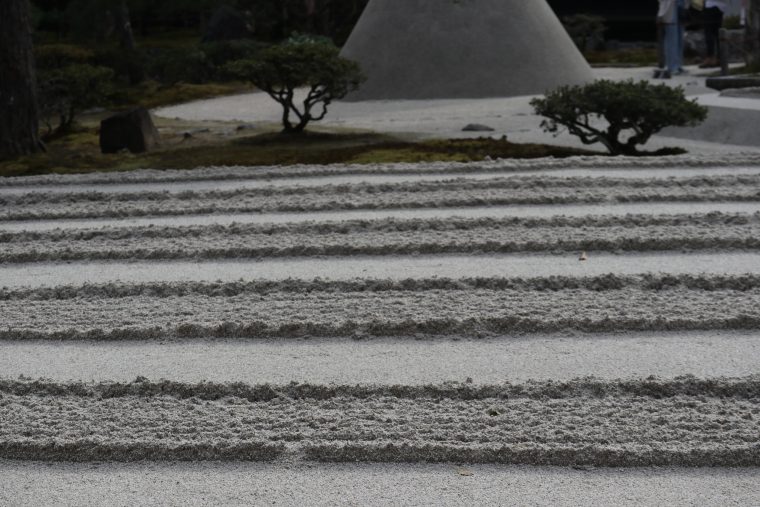
Ingenious sand heaping.
Within the precincts of Ginkakuji Temple, there are two distinctive sand mounds known as Ginsyadan and Kogetsudai.
Ginsyadan, situated in front of the Hojo (Abbot’s chamber), is formed from Shira-kawa sand into a wave-like shape, standing at approximately 60cm tall. It is said to reflect the light of the moon, hence its name, and is also interpreted as representing the waves of China’s West Lake.
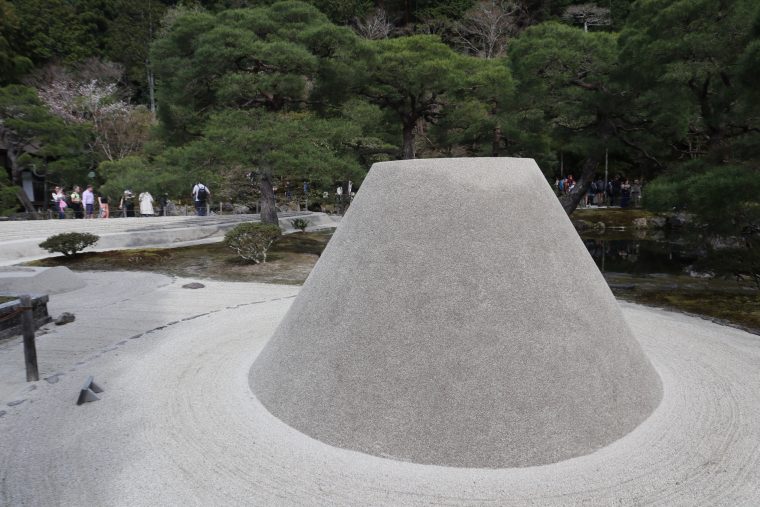
On the other hand, Kogetsudai is a raised mound of Shira-kawa sand, towering over 180cm tall, surpassing the height of an adult. It is speculated to have been created for the purpose of observing the moonrise over the Higashiyama mountains. Some also believe it plays a role in reflecting moonlight onto the main hall.
These sand mounds contribute to the picturesque landscape of Ginkakuji Temple, leaving a lasting impression on visitors. However, their precise roles and meanings remain unclear. Due to their association with the moon, they have contributed to the image of Ginkakuji Temple as a place intertwined with the concept of the moon.
Tenbojo (Map15)
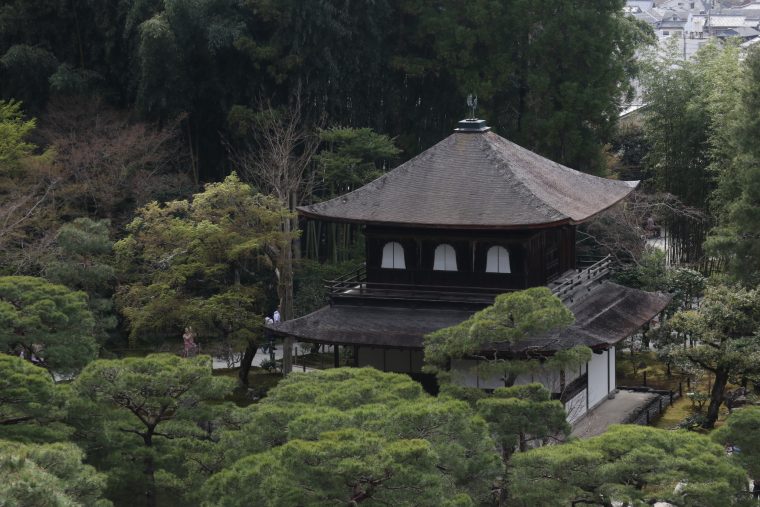
View of Kannonden Ginkaku from the observation deck.
Within the grounds of Ginkakuji Temple lies an observation deck, offering panoramic views of the entire precinct.
Perched atop a small hill within the grounds, the view of Ginkakuji Temple from this vantage point is often praised for its beauty. Visitors can behold the sight of Ginkakuji Temple harmonizing with the changing seasons, with its splendor particularly heightened during the autumn foliage.
Moreover, from the observation deck, visitors can also admire other buildings within Ginkakuji’s precinct, such as the Kannonden Ginkaku, Togudo, and the Rouseitei tea house.
However, please be cautious as the path to the observation deck is somewhat steep. The view from the observation deck allows visitors to experience the tranquility and elegance of Ginkakuji Temple, so be sure to make the journey when you visit.
Ochanoi (Map18)
The ‘Ochanoi’ well within the precincts of Ginkakuji Temple was a favored well by Ashikaga Yoshimasa, known for its abundant water quality, and it continues to be used today for beverages such as tea ceremonies. This well is said to have contributed to the development of the Japanese tea ceremony.
The area surrounding the Ochanoi well still retains the original stonework from that time, with stone arrangements serving as focal points for the tea garden and the source of the tsukubai (water basin).
These elements have influenced the design of traditional Japanese gardens and tea rooms, deeply rooted in Japan’s aesthetics and culture.
Other Useful Information
Special viewing
The interior of Togudo is usually not open to the public, except during special viewing periods in spring and autumn.
During these special viewings, visitors can experience the elegant lifestyle of Ashikaga Yoshimasa and get a glimpse into the lifestyle of the shogun. Since such exhibitions are rare, it is highly recommended to visit at least once to experience Japanese history firsthand.
Links
See also the official website of Ginkakuji Temple for reference.
https://www.shokoku-ji.jp/en/ginkakuji/
3 tourist spots around Ginkakuji Temple
Around Ginkakuji Temple, there are many tourist attractions. Here are three of them:
- The Philosopher’s Path: A scenic walking path where you can enjoy the beauty of cherry blossoms in spring, fresh greenery in summer, and vibrant autumn leaves. Stretching about 2 km from Ginkakuji Temple to Nanzenji Temple, you can appreciate nature’s changing seasons along the way.
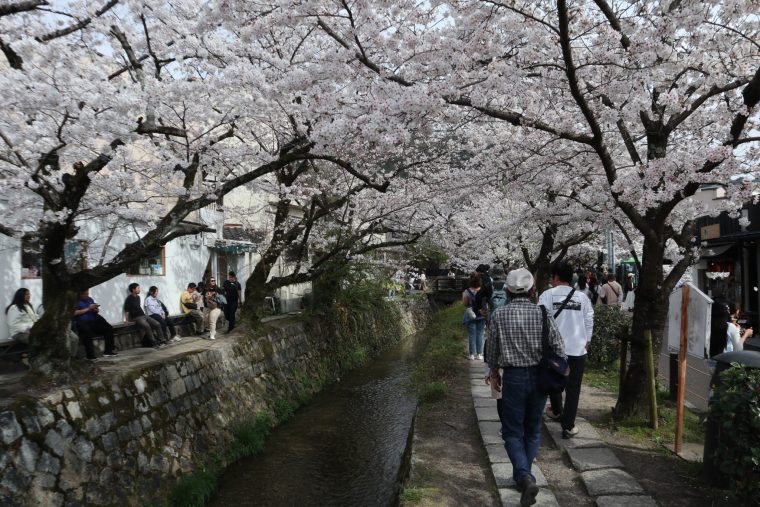
- Nanzenji Temple: Located just south of Ginkakuji Temple, Nanzenji Temple is renowned for its beautiful gardens and historic architecture. One of its most famous features is the “Suirokaku,” Japan’s oldest aqueduct.
- Heian Shrine: Built in 1895 to commemorate the 1100th anniversary of the Heian Capital, Heian Shrine boasts striking vermilion buildings and a grand torii gate. Especially during cherry blossom season, it attracts numerous visitors.
Make sure to visit these spots when you explore Ginkakuji Temple.
Ginkakuji Temple encapsulates the culture and aesthetics of the Muromachi period
Projecting the aesthetic and religious views of Ashikaga Yoshimasa, Ginkakuji Temple is a symbol of the Higashiyama culture, in which the spirit of “wabi-sabi,” the worldview of the samurai and Zen sects, lives on.
Ginkakuji Temple has no Daibutsuden (Great Buddha Hall) and no glittering decorations, but only a garden, Kannonden, and Togudo.
Nevertheless, many people visit Ginkakuji Temple because of its serene beauty and calm atmosphere. Ginkakuji Temple has a different appearance in each of the four seasons. You will discover something new every time you visit.

